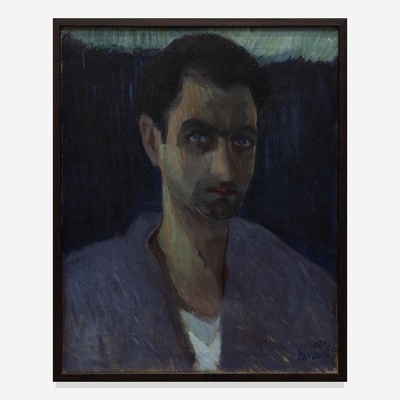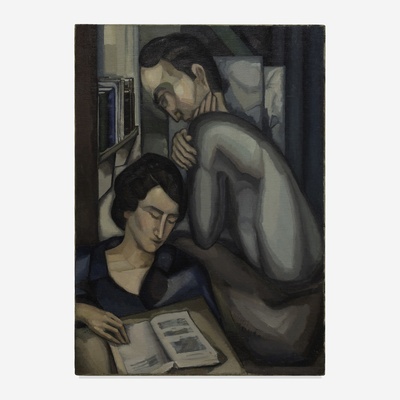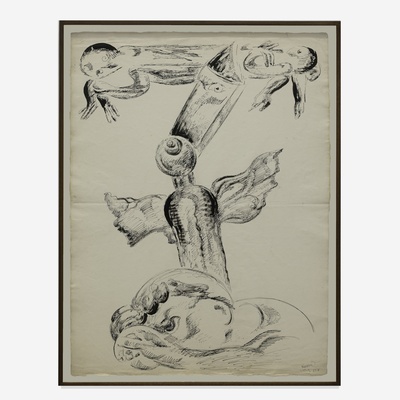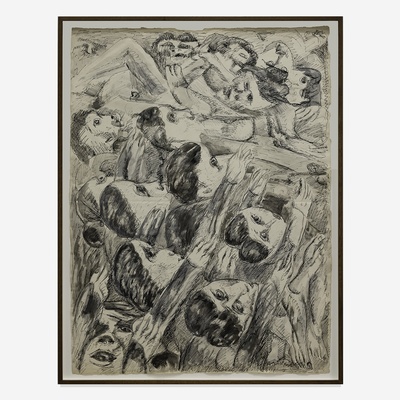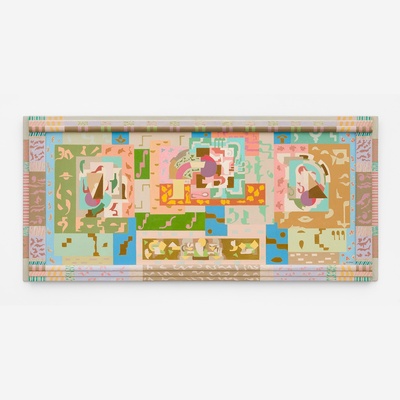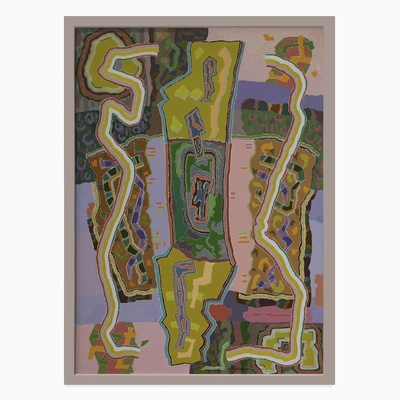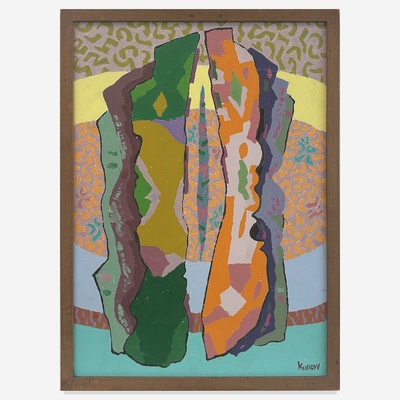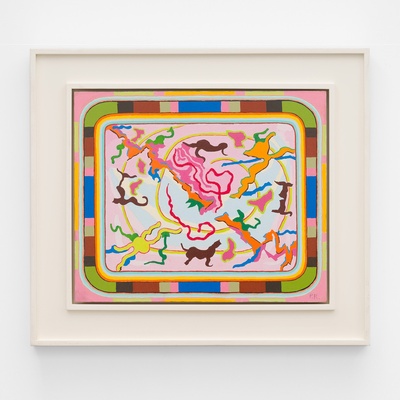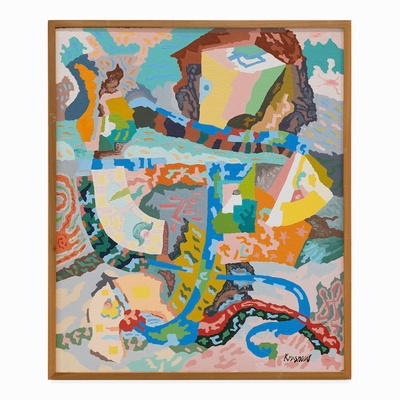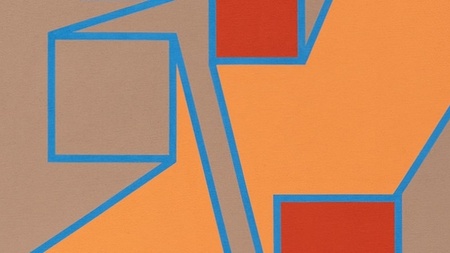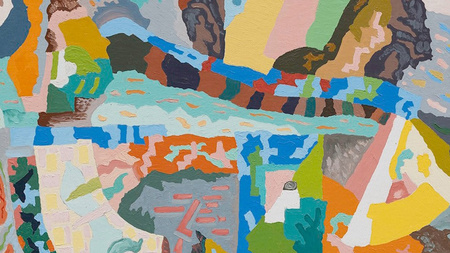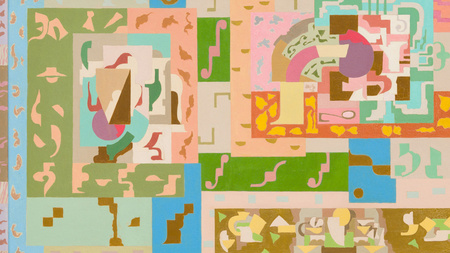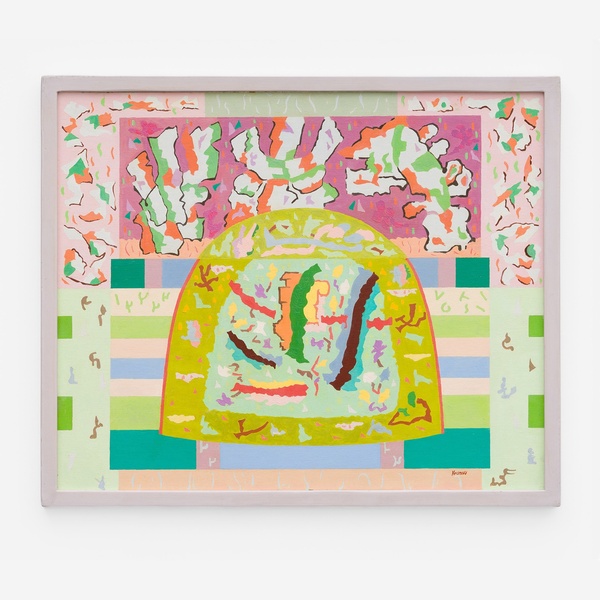
Peter Krasnow
Peter Krasnow, Selt Portrait, 1920. Oil on canvas. 20 3/4 x 16 3/4 inches; 21 3/4 x 17 3/4 inches, framed.
Peter Krasnow, August 8, 1937, 1937. Ink and watercolor paper. 31 x 23 inches; 33 1/4 x 25 1/4 inches, framed.
Peter Krasnow, Untitled, 1959 circa. Oil on board. 13 1/4 x 9 1/2 inches; 14 3/8 x 10 3/4 inches, framed.
Exhibitions
Frieze Los Angles 2026
Felix Art Fair 2025
Peter Krasnow
1887 Born in Zawill, the Jewish Ghetto of Zviahel, Ukraine
1979 Died in Los Angeles, CA
PERMANENT COLLECTIONS:
Cardozo Law School Art Collection, New York, NY
Carnegie Museum of Art, Museum of Art, Pittsburgh, PA
DeSaisset Museum, Santa Clara University, Santa Clara, CA
Hammer Museum, Los Angeles, CA
Herzliya Museum of Art, Herzilya, Israel
Huntington Library Art Collections & Botanical Gardens, San Marino, CA
Israel Museum, Jerusalem
The Jewish Museum, New York, NY
Jack & Shanaz Langson Institute & Museum of California Art, Irvine, CA
Judah L. Magnes Museum, Berkeley, CA
Laguna Art Museum, Laguna Beach, CA
Long Beach Museum of Art, Long Beach, CA
Los Angeles County Museum of Art, Los Angeles, CA
McNay Art Museum, San Antonio, TX
Monterey Museum of Art, Monterey, CA
National Portrait Gallery, Washington, D.C
Nora Eccles Harrison Museum of Art, Logan, UT
Norton Simon Museum, Pasadena, CA
Oakland Museum of California, Oakland, CA
Palm Springs Art Museum, Palms Springs, CA
Phoenix Art Museum, Phoenix, AZ
Ruth Chandler Williamson Gallery, Scripps College, Claremont, CA
San Francisco Museum of Modern Art, San Francisco, CA
San Jose Museum of Art, San Jose CA
Santa Barbara Museum of Art, Santa Barbara, CA
Sheldon Museum of Art, Lincoln, NE
Skirball Cultural Center, Los Angeles CA
Smithsonian American Art Museum, Washington, D.C.
Spertus Museum, Chicago, IL
University of Arizona Museum of Art, Tucson, AZ
University of Judaism, Los Angeles, CA
University Art Museum, Berkeley, CA
University of Southern California, Los Angeles, CA
Whitney Museum of American Art, New York, NY
EDUCATION
1909-1915 Studied art at the Art Institute of Chicago under Harry Mills Wolcott
SOLO EXHIBITIONS
2024 Peter Krasnow, Babst Gallery, Los Angeles, CA
2023 Peter Krasnow: Breathing Joy and Light, Skirball Cultural Center, Los Angeles, CA
2016 Peter Krasnow: Maverick Modernist, Laguna Art Museum, Laguna Beach, CA
2007 Peter Krasnow, Tobey C. Moss Gallery, Los Angeles, CA
1996 Peter Krasnow: A Retrospective Exhibition, Tobey C. Moss Gallery, Los Angeles, CA
1994 Peter Krasnow: Sculptor and Draftsman, Nora Eccles Harrison Museum of Art, Utah State University, Logan, UT
1993 Peter Krasnow: Sculpture, Painting, Drawings, Tobey C. Moss Gallery, Los Angeles, CA
1991 Peter Krasnow: An Evolving Vision: Painting, Sculptures, Prints, Drawings, Tobey C. Moss Gallery, Los Angeles, CA
1989 Peter Krasnow, California Modernist, Sculpture, Drawing and Lithographs, Tobey C. Moss Gallery, Los Angeles, CA
1986 Peter Krasnow (1887-1979): Paintings, Sculpture, Drawings Prints. Tobey C. Moss Gallery, Los Angeles, CA
1977-1979 Peter Krasnow: A Retrospective Exhibition of Paintings, Sculpture and Graphics, Skirball Cultural Center, Hebrew Union College, Los Angeles
1977 Peter Krasnow: A Retrospective of Exhibition of Paintings, Sculpture and Graphics. Judah L. Magnes Museum, Berkeley, CA
1976 Peter Krasnow in Retrospect: Paintings and Sculpture 1920-1976, California State University Bakersfield Galleries, Bakersfield, CA
1976 Peter Krasnow, Temple Emanu-El Museum, San Francisco, CA
1975 Peter Krasnow: Works from 1919 to the Present, Los Angeles Municipal Art Gallery, Barnsdall Park, CA
1964 The Work of Peter Krasnow 1907 to 1964: A Retrospective Exhibition of Paintings, Sculptures, Drawings and Prints, Lang Art Gallery, Scripps College, Claremont, CA
1962 Paintings and Sculpture by Peter Krasnow, Temple Emanu-El Museum, San Francisco, CA
1961 Peter Krasnow: Paintings and Sculpture, Los Angeles Art Association, Los Angeles, CA
1961 Paintings by Peter Krasnow, Ernest Raboff Gallery, Los Angeles, CA
1954 Peter Krasnow: 35 Years of His Art, Pasadena Art Institute, Pasadena, CA
1946 Peter Krasnow, Little Gallery, Louisville, KY
1945 Peter Krasnow, Education Building, University of California, Los Angeles, Los Angeles, CA
1943 Sculpture and Watercolors by Peter Krasnow, Beverly-Fairfax Community Center, Los Angeles, CA
1941 Peter Krasnow, Stendahl Galleries, Los Angeles, CA
1940 Peter Krasnow, University of California, Los Angeles, CA
1939 Peter Krasnow, Fine Arts Gallery of San Diego, San Diego, CA
1935 Watercolors and Wood Carvings by Peter Krasnow, The Print Rooms, Los Angeles, CA
1934 Peter Krasnow: Paintings, Wood Carvings and Drawings, Art Gallery, Administration Building, University of California Los Angeles, Los Angeles, CA
1934 Peter Krasnow: Lithographs, Wood Cuts and Monotypes, New Gallery, Los Angeles, CA
1934 Oeuvres de Peter Krasnow, Galerie Pierre, Paris, France
1931 Peter Krasnow: Paintings, Drawings, Wood-Blocks, Pastels and Sculpture, California Palace Legion of Honor, San Francisco, CA
1931 Courvoisier Gallery, San Francisco, CA
1931 Gelber and Lilienthal Book Store, San Francisco, CA
1930 Works by California Artists, Curated by Marga Heilbuth, Exhibited in Tokyo, Kyoto, Shanghai, Beijing and Honolulu, HI
1930 Wood Panels by Peter Krasnow, Art Gallery of the City Art Commission, City Hall, Los Angeles
1930 Wood Carvings by Peter Krasnow, Stendahl Art Galleries, Los Angeles, CA
1930 Peter Krasnow Lithographs, Galerie Beaux Arts Association, San Francisco, CA
1929 Scripps College, Claremont, CA
1929 Bas Reliefs by Peter Krasnow, Braxton Galleries, Los Angeles, CA
1929 Paintings, Lithographs, Drawings and Sculpture by Peter Krasnow, Dalzell Hatfield Gallery, Los Angeles, CA
1928 Peter Krasnow: Woodcarvings and Paintings, Western Association of Art Museum Directors, Oakland Art Gallery, Oakland, CA
1928 Wood Carvings and Paintings by Peter Krasnow, Los Angeles Museum Exposition Park, Los Angeles, CA
1928 Peter Krasnow: Wood Carvings and Paintings, Seattle Society of Fine Arts, Seattle, WA
1928 Lithographs by Peter Krasnow, Zeitlin Bookstore, Los Angeles, CA
1928 Los Angeles Public Library, Los Angeles, CA
1928 Peter Krasnow (part of the Inaugural Exhibition), Los Angeles Museum at Exposition Park (now the Los Angeles County Museum of Art), Los Angeles, CA
1927 Peter Krasnow: Wood Carvings, Temple Emanu-El, San Francisco, CA
1927 California School of Fine Arts, San Francisco, CA
1927 Paintings and Drawings by Peter Krasnow, Oakland Art Gallery, Oakland, CA
1926 Lithographs by Peter Krasnow, Courvoisier Gallery, San Francisco, CA
1925 The Print Rooms, Los Angeles, CA
1923 Paintings by Peter Krasnow, MacDowell Club of Allied Arts, Tajo Building, Los Angeles, CA
1923 Peter Krasnow, The Ebell, Vernon Branch Library, Los Angeles, CA
1922 Paintings by Peter Krasnow, Jefferson High School, Los Angeles, CA
1922 Whitney Studio Club (now the Whitney Museum of American Art), New York, NY
1922 Peter Krasnow, Los Angeles Museum, Exposition Park, Los Angeles, CA
GROUP EXHIBITIONS
2025 2025 A Quiet Room, Babst Gallery, Los Angeles, CA
2023 Mid-Century Geometric Abstraction in the Modern Art Galleries, Los Angeles County Museum of Art, Los Angeles, CA
2023 Visions and Values, Skirball Cultural Center, Los Angeles CA
2023 California: Now and Then, BG Gallery, Santa Monica, CA
2022 SKY SPACE TIME CHANGE, Laguna Art Museum, Laguna Beach, CA
2020 Artists on Artists, Spencer Helfen Fine Arts, Beverly Hills, CA
2019 California Bauhaus: Influence & Adaptation, Sullivan Goss, Santa Barbara, CA
2017 Maven of Modernism: Galka Scheyer in California, Norton Simon Museum, Pasadena, CA
2017 Collecting on the Edge, Nora Eccles Harrison Museum of Art, Logan, UT
2016 Surreal / Unreal, Jack Rutberg Fine Arts, Pasadena, CA
2016 Tinseltown in the Rain: The Surrealist Diaspora in Los Angeles, 1935-1969, Richard Telles Fine Art, Los Angeles, CA
2014 Enchanted Modernities: Mysticism, Landscape, and the American West, Norra Eccles Harrison Museum of Art, Logan, UT
2009 Collecting California: Selections from Laguna Art Museum, Laguna Art Museum, Laguna Beach, CA
2009 California Calling, Santa Barbara Museum of Art, Santa Barbara, CA
2008 Americans: Paintings and Photographs from the National Portrait Gallery, The National Portrait Gallery, The Smithsonian, Washington, D.C.
2003 American Expressionism: Art and Social Change, 1920-1950. Columbus Museum of Art, Columbus, OH
2001 Telling Time: To Everything There is a Season, Judah L. Magnes Museum, Berkeley, CA
2001 Lay of the Land, Carnegie Art Museum, Oxnard, CA
2001 One Minute of Your Time, Laguna Art Museum, Laguna, CA
2000 Circles of Influence: Impressionism to Modernism in Southern California, Orange County Museum of Art, Costa Mesa, CA
1997 Singular Impressions: the Monotype in America, The Smithsonian, Washington, D.C.
1997 California Modernism and Abstraction, Tobey C. Moss Gallery, Los Angeles, CA
1996 New Beginnings, The Skirball Museum, Los Angeles, CA
1996 On the Edge of America: California Modernist Art, Jack Rutberg Fine Art, Pasadena, CA
1996 Assemblage and Collage, Tobey C. Moss Gallery, Los Angeles, CA
1995 Pacific Dreams: Currents of Surrealism and Fantasy in California Art, University of California, Los Angeles; Traveled to the Oakland Art Museum, Oakland, CA; Nora Eccles Harrison Museum of Art, Utah State University, Logan, UT
1995 Contacting Pablo Picasso: The Influence of Picasso on American Printmakers, The Spanish Institute, NY, NY
1993 The Shtetl Life: The Nathan and Faye Hurvitz Collection, Judah L. Magnes Museum, Berkeley, CA
1993 75 Works, 75 Years: collecting the Art of California, Laguna Art Museum, Laguna Beach, CA
1992 Modernist Abstraction in American Prints, Laguna Art Museum, Laguna Beach, CA
1990 Turning the Tide: Early Los Angeles Modernists, 1920-1956, Laguna Art Museum, Los Angeles, CA; Traveled to U.C Santa Barbara, Santa Barbara, CA; Oakland Art Museum, Oakland, CA; Nora Eccles Harrison Museum of Art, Utah State University, Logan, UT; McNay Art Museum, San Antonio, TX; Palm Springs Desert Museum of Art, Palm Springs, CA
1990 The Circus, Tobey C. Moss Gallery, Los Angeles, CA
1989 The Rudolf L. Baumfeld Collection of Landscape Drawings and Prints, Grunewald Center for the Graphic Arts, Los Angeles, CA
1989 Forty Years of California Assemblage, University of California, Los Angeles, CA; Traveled to San Jose Museum of Art, San Jose, CA; Fresno Art Museum, Fresno, CA; Joslyn Art Museum, Omaha, NE
1989 Blueprints for Modern Living, Museum of Contemporary Art, Los Angeles, CA
1988 The Bible as Source: Prints and Drawings, Tobey C. Moss Gallery, Los Angeles, CA
1986 Aspects of California Modernism: 1920-1950, Federal Reserve Board Gallery, Washington, D.C.
1985 California Modernism, Tobey C. Moss Gallery, Los Angeles, CA
1985 Art at the Platt, University of Judaism, Los Angeles, CA
1984 Between the Olympics- Los Angeles, 1932-1994, Tobey C. Moss Gallery, Los Angeles, CA
1984 Jewish Music, University of Judaism, Los Angeles, CA
1984 Fifty Years of California Prints: 1900-1950, The Annex Galleries, Santa Rosa, CA
1981 California Modernism, Tobey C. Moss Gallery, Los Angeles, CA
1981 Los Angeles 1920s- 1960s, Tobey C. Moss Gallery, Los Angeles, CA
1981 California: the State of Landscape, 1972-1981: Newport Harbor Art Museum, Newport Beach, CA
1981 Southern California Artists, 1940-1980, Laguna Beach Museum of Art, Laguna Beach, CA
1980 Vanguard American Sculpture 1913-1939, Oakland Museum of Art, Oakland, CA
1980 Los Angeles Prints, 1883-1980, Los Angeles County Museum of Art, Los Angeles, CA
1980 Painting and Sculpture in Los Angeles: 1900-1945, Los Angeles County Museum of Art, Los Angeles, CA
1979 Inaugural Exhibition, Museum of Contemporary Art Los Angeles, Los Angeles, CA
1977 Painting and Sculpture in California: The Modern Era, Whitney Museum of American Art, New York, NY
1977 National Museum of American Art, Washington, D.C.
1976 The Blue Four: Galka Scheyer Collection, Norton Simon Museum of Art, Pasadena, CA
1976 Painting and Sculpture in California: The Modern Era, San Francisco Museum of Modern Art, San Francisco, CA
1974 Nine Senior Southern California Painters, Los Angeles Institute of Contemporary Art, Los Angeles, CA
1970 The Life and Times of Sadakichi Hartman, University of California at Riverside University Library, Riverside, CA
1967 Tenth Anniversary Exhbition, Temple Emanu-El, San Francisco, CA
1965 Art Now, Los Angeles Art Association Gallery, Los Angeles, CA
1965 Living With Art: San Marino Leagues' Fifth Biennial Art Walk, Pasadena, CA
1965 John Barbour, Lundeberg, McLaughlin, Fietelson, Hammersley, Peter Krasnow, Elise Cavanna, Eva Slater, Karl Benjamin, Esther Robles Gallery, Los Angeles, CA
1965 Peter Krasnow, Max Band, Boris Deutsch, Westside Jewish Community Center, Los Angeles, CA
1963 Across the Decades: The 30th Anniversary Exhibition, Los Angeles Art Association, Los Angeles, CA
1961 The Collection of David Spector, Oakland Jewish Center, Oakland, CA
1961 Print Show, San Francisco Museum of Modern Art, San Francisco, CA
1960 Art of Southern California, San Francisco Museum of Modern Art, San Francisco, CA
1960 Fifty Paintings by 37 Artists, University of California Los Angeles Art Galleries, Los Angeles, CA
1959 Californians Collect Californians, Westside Jewish Community Center, Los Angeles, CA
1958 Haggin Galleries & Pioneer Museum, Stockton, CA
1957 California Drawings, Long Beach Museum of Art, Long Beach, CA
1956 Pacific Coast Art: United States Representation at the Il Bienal of Sao Paulo, San Francisco Museum of Art, San Francisco, CA; Traveled to Cincinnati Art Museum, Cincinnati, OH, Colorado Springs Fine Art Center, Colorado Springs, CO, and Walker Art Center, Minneapolis, MN
1956 American Institute of Architects, Los Angeles, CA
1955 IIII Bienal, Museu de Art Modena, Sao Paulo, Brazil
1952 A Decade in the Contemporary Gallery, Pasadena Art Museum (now the Norton Simon Museum), Pasadena, CA
1951 Royer's Gallery, Los Angeles, CA
1950 Exhibition of Artists of Los Angeles and Vicinity, Los Angeles County Museum of Art, Los Angeles, CA
1949 Southern California 1948, Modern Institute of Art, Beverly Hills, CA
1943 Dorothy Moore Bequest, Los Angeles County Museum of Art, Los Angeles, CA
1939 Eleventh Southern California Exhibition, Fine Arts Gallery of San Diego, San Diego, CA
1936 American Artists' Congress, Rose Art Galleries, Los Angeles, CA
1935 College Art Club, Santa Maria High School, Santa Maria CA
1935 Portland B'nai B'rith Center, Portland, OR
1935 Lithographs and Block Prints by Peter Krasnow, Santa Maria's First Annual Art Festival, Santa Maria High School, Santa Maria, CA
1935 Sixteenth Annual Painters and Sculptors Exhibition, Los Angeles County Museum of Art, Los Angeles, CA
1935 California Pacific International Exposition, Palace of Fine Arts, San Diego, San Diego, CA
1932 Mrs. Leslie M. Maitland's Private Collection of Paintings, Drawings and Prints, Dallas Art Association, Dallas Public Art Gallery, Dallas, TX
1931 Fifth Annual Exhibition of the Philadelphia Society of Etchers, de Young Museum, San Francisco, CA
1931 53rd Annual Exhibition of the San Francisco Art Association, de Young Museum, San Francisco, CA
1931 Local Lithographers, Art Department, University of California, Los Angeles, CA
1930 California Room, California Palace of the Legion of Honor, San Francisco, CA
1930 1930 Annual Exhibition, Oakland Art Gallery, Oakland, CA
1930 Jewish Community Center, San Francisco, CA
1929 Paintings by Conrad Buff, Henri de Kruif, Haldane Douglas, Clarence Hinkle, Peter Krasnow and Edouard Vysekal, Stendahl Galleries, Los Angeles, CA
1929 1929 Annual Exhibition, Oakland Art Gallery, Oakland, CA
1929 Decorative Arts Exhibition, Woman's City Club, San Francisco, CA
1928 Black and White, Brick Row Gallery, Hollywood, CA
1928 Exhibition of Modern Art, Hale Brothers Department Store, San Francisco, CA
1928 Peter Krasnow, Exhibited by the Western Art Association, J.B. Speed Memorial Museum, Louisville, KY
1928 Exposition of the Decorative Arts of Today, Bullock's, Los Angeles, CA
1929 International Exposition of Art in Industry, Macy's Department Store, New York, NY
1929 Prints by Californians, Los Angeles Public Library, Los Angeles, CA
1927 Five Artists Show, Council of Jewish Women, Los Angeles, CA
1927 Forty-Ninth Annual Exhibition of San Francisco Art Association, Palace of Fine Arts, San Francisco, CA
1927 Temple Emmanuel, San Francisco, CA
1927 Annual Painters' and Sculpturs' Exhibition, Los Angeles Museum, Los Angeles, CA
1927 Whitney Studio Club Annual, Whitney Studio Club (now the Whitey Museum of American Art), New York, NY
1927 Fifth Annual Exhibition, Oakland Art Gallery, Oakland, CA
1927 Synchronism, Los Angeles Museum Exposition Park (now the Los Angeles County Museum of Art), Los Angeles, CA
1926 Paintings by Warren Wheelock, Conrad Buff, Boris Deutsch, and Peter Krasnow, Stone International Galleries, Monrovia, CA
1926 Barker Brothers, Los Angeles, CA
1926 Whitney Studio Club Annual, Whitney Studio Club (now the Whitney Museum of American Art), New York, NY
1925 Whitney Studio Club Annual, Whitney Studio Club (now the Whitney Museum of American Art), New York, NY
1925 Pan American Exhibition of Oil Paintings, Los Angeles Museum Exposition Par (now the Los Angeles County Museum of Art)k, Los Angeles, CA
1923 The Group of Independent Artists, MacDowell Club Galleries, Los Angeles, CA
1923 Exhibition of Painters and Sculptors in Southern California, Los Angeles Museum, Exposition Park (now the Los Angeles County Museum of Art), Los Angeles, CA
1922 Sixth Annual Exhibition of the Society of Independent Artists, The Waldorf Astoria, New York, NY
1922 Whitney Studio Club Annual, Whitney Studio Club (now the Whitney Museum of American Art), New York, NY
1922 Paintings by John Coolidge, Peter Krasnow, Jean Mannheim, and E. Roscoe Shrader, Los Angeles Museum of History, Science and Art (now the Los Angeles County Museum of Art), Los Angeles, CA
1921 Whitney Studio Club Annual, Whitney Studio Club (now the Whitney Museum of American Art), New York, NY
1915 AIC Annual, The Art Institute of Chicago, Chicago, IL
Biography
1887 Born in Zawill, the Jewish Ghetto of Zviahel, Ukraine
1905 Novograd Volynsk targeted by pogroms organized by anti-Semitic the Black Hundreds
1907 Immigrated to Boston, where he lived a small tenement district, where he enrolled in night-school art-classes at the Mechanics Building
1909 Moved to Chicago where he lived on the West-Side Jewish ghetto, and enrolled at the night-classes at the Art Institute of Chicago while working as a security officer. He studied under Harry Mills Wolcott.
1915 Graduated from the School of the Art Institute of Chicago
1916 Met writer, poet and scholar Rose Bloom at a local community center, who was looking for a children's art teacher.
1917 Moved to New York City where he lived with friend Olef Olesson, where they frequented Greenwich Village.
1920 Rose moved to New York City. They married and moved to the Lower East Side. Rose got a job as a case worker in Harlem to support Peter's art practice.
1922 Drove across country to California
1923 Arrived in Southern California and settled in Glendale
1924 Began building their home and studio on Edward and Flora Weston's land
1920s Accepted commissions for paintings carvings from Temple Emmanu-El, San Francisco; Sinai Temple, Los Angeles; University of Southern California, Los Angeles; Bullock's Los Angeles
1927-1928 Created a series of lithographs
1932 Stayed in Paris for Nine Months
1933-34 Moved to the Dordogne region of France where he exchanged letters with Edward Weston concerning political conditions.
1934 Returned to Atwater Village, focusing on a series wood sculptures
1941 Pearl Harbor
1941 Returned to painting
1977 Received a fellowship from the National Endowment for the Arts
1979 Died in Los Angeles at the age of 92
Peter Krasnow (1886-1979) was born in 1886 in Zawill, the Jewish ghetto of Zviahel, Ukraine. As a boy he was an apprentice to his father, a house painter and worked learning how to grind and blend colors before he knew the alphabet. After escaping the murderous pogroms, he came the United States, and convinced his father, who disapproved of his desire to become an artist, to emigrate to Boston in 1907 when he was 20 years old.
It took several years before he was able enough money to attend the Chicago Art Institute in 1908-1915, where, for extra money, he worked as a night security officer. In Chicago he lived in the Jewish ghetto on the Westside, near the Maxwell Street Market. He writes that painting at the market, "sketching untiringly at ever paintable subject my eyes lighted upon. My people--the garrulous voice of the vendor of the shoddy merchandise...the child, emaciated and rickety, carrying home bundles of unfinished coats and suits for night work. The whole unkempt unrelieved kaleidoscope was mine for the taking. I was part of it, a part of that unbroken family always divided and never parted. I began to make selections finding those who were near to me. I saw my father, my step-mother...my whole town of relatives and friends were all massed in the single block of canvas-shrouded carts that made up my painting."
To make money, gave art lessons through a social agency and there he met Rose Bloom (1885-1984), a writer of poetry, short stories and plays, as well as a social worker. On his second time meeting Rose, she "explained. She is leaving for her vacation. The boat she is taking sails in an hour. She is going to an ideal spot, far from the summering crowds, where the earth meets the stars and the Northern Lights encircle the sky 'An Artist's country. You must come.' When I finally understood that she meant for me to come along I told her stiffly that a vacation was a luxury I could not at present afford. I had no funds and must find work. 'You will come.' With finality. 'And the expense?' 'Charged to your unpainted pictures.' It was settled.' When they arrived at the each, Rose insisted he paint, he told her he had no easel. So she "removed her shoes and stockings, waded into the half-submerged hut, wrenched a board off somewhere and brought it to me. I still dissembled. 'It is not wide enough.' She went back and brought another, salvaged some nails, picked up a stone and laid it ceremoniously at my feet." They were married in 1920.
That year, Peter set off for New York, where he lived in a tenement the Lower East Side. Rose later joined him, supporting his career as a case worker in lower Harlem. That year, due to as Rose would say, Rose’s “scouting and salesmanship,” he had solo exhibitions at the Whitney Studio Club (the forerunner to the Whitney Museum of American Art) and the Los Angeles County Museum of Art. After two years in the art scene in New York, Wary of recognition and afraid of “selling out,” he decided to flee what he called the “crowded and unfriendly East Coast.” Inspired by a California license plate he saw on a passing car, he decided to go West. In an “Old Tin Lizzie,” Peter and Rose Krasnow made a six-month journey toward California, living and painting out of his car.
Shortly after arriving in Los Angeles, they met photographer Edward Weston, who invited them to pitch a tent on his property near the Los Angeles river. They soon bought it (with a $10 down-payment) and later built a redwood cabin, which was built "without blueprint or plan, without knowledge of building or carpentry, with only lumber, hammer, saw, and nails, I built a studio in Los Angeles in 1923. I planted a garden with trees and flowers on this plot of land I had been able to acquire across the river from Griffith park" where the Krasnow's cultivated "one of the most impressive, seemingly wild, succulent gardens in Southern California." Krasnow said, "I planted shade and fruit trees, shrubs and flowers. Soon green shoots began to show. The dry barren land had been transformed into a garden. I worked hard with shovel and hoe. I did not know much about making growing things grow, but I felt as I learned a new vocabulary, irrigation, cultivation, pruning, fertilizing, that he contact with the soil--the planting of trees--the building of the house--had transformed me too."
It was there, that Krasnow said "I was not troubled by the change of light which newcomers complained of upon arrival here. I was creating color schemes independent of the changeable color and unsteady light of this semi-tropical landscape. Winter passed by unnoticed, spring was on the calendar; the change was hardly perceptible, the garden had bloomed all winter through."
At the time, Los Angeles was on the cusp of a cultural explosion involving artists, poets, and writers who brought Modernism to the West coast. In addition to Weston, the Krasnows’ home became a favorite meeting place for artists and intellectuals living in Los Angeles. The Krasnows considered architects Rudolf Schindler and Richard Neutra, actor Sadakichi Hartmann, and artists Lorser Feitelson, Helen Lundeberg, and Henrietta Shore as friends.
It was during this period in the late 1920s that Krasnow began to receive a series of portrait commissions, which heavily emphasized the art deco style with heavy outlines and architectural forms. He also did a series of linocuts and lithography, which he worked on through the 1920s. One of his lithographs from 1928, Stallion, is inspired by California poet Robinson Jeffers’ poem “Roan Stallion” (1925), which describes the Edenic landscape as untouched, where “no man nor his mount had ever ventured.”
In 1931, Krasnow had a successful solo exhibition at the California Palace of the Legion of Honor in San Francisco. However, Krasnow felt that the exhibition was "highly praised in all quarters and I was dubbed a genius. This acclaim set in motion a process of thinking and evaluating. I felt it was all premature. I should develop my work further to be worthy of it. A great urge to see more of the art world, to learn and to advance took possession of me that summer. I must go away. Where? France, then the art capital of the world."
So once again to elude fame, Peter and Rose Krasnow took off, this time to France, to the Dordogne region, “a long journey to become the man I was to be.” In Paris, Krasnow was able to see the work of Parisian Modernists firsthand. But "by happy chance, I was able through the advice of a French artist to spend the summer in the Dordogne region, in a village almost prehistoric where no foreigner had set foot before. I rented a one-hundred year-old stone house and began to work. I had done some watercolors before of little account. This country just cried out to be painted. I concentrated on watercolor being the best possible for transportation and storing."
“When the weather grew too cold for Krasnow to paint outdoors, he decided to leave. But his French neighbors didn’t want him to go. They held a meeting, he says, and voted toggle him their city hall as a studio. Handing the artist a 10 inch hand-wright-iron key, the villagers urged him to stay on, praising the building’s lighting and promising him firewood.” (Barbara Isenberg “Peter Krasnow at 90,” the Los Angeles Times, September 4, 1977.)
In 1934, Krasnow exhibited these watercolors, monotypes, and some paintings at the Galerie Pierre in Paris. Soon after, it was time to return to Los Angeles—as Krasnow wrote in his unpublished autobiography, “The black shadows that had already begun to close about Europe were looming stronger in the perspective of the most optimistic.' c’est la Guerre.’”
So the Krasnows again returned to Los Angeles, where Peter Krasnow embarked on a series of ink drawings. In Peter Krasnow: Maverick Modernist, Michael Duncan writes, "a group of 1937 ink drawings of figures in tortuous poses under a dictatorial thumb were responses to the Spanish Civil War. In the midst of World War II, Krasnow stumbled across a newspaper account of the complete devastation by the Axis of the Ukrainian village he grew up in."
After Pearl Harbor in 1941, Krasnow returned to painting. He said, “I painted again as darker grew the nights and bleaker the days. Between alerts, black outs, rationing, brighter grew my palette…symmetry for order, color and light. Now when tragedy was at the deepest point, my paintings breathe joy and light—color structure instead of battle scenes, symmetry to repair broken worlds.”
It was at this moment that Krasnow began “to eliminate outline, blending of color and perspective” concentrating on flatness and color. In this series, he applied the paint directly from the tube to retain their original purity, where color plays “upon the surface, creating pools of light, forming color structures instead of color strokes.”
"Could I discover [a new way of painting] by discarding all that I had been taught, practiced, and produced, eliminate all the spurious growth and save the roots and let painting stand upon its own strength of Color and Form to create meaning--a new concept of color structures instead of color strokes."
In the 1940s, Krasnow refused to engage with the commercial gallery system, only exhibiting only in non-profit institutions, and selling directly to a select few collectors, while living off of his wife’s teaching salary and his own few commissions and sales. He viewed his paintings sacred: while painting he “experienced moments of illumination in which he received miraculous insights form some unknown source.”
His isolation kept his paintings from “subscrib[ing] to no period or school.” Arthur Millier once referred to Krasnow as a “critic’s puzzle” and Fidel Daniele, wrote that “I remember being depressed as a review because there was nowhere I could stick him… He had no roots I could see.” Rose continued to support the couple by teaching Hebrew and Jewish folklore classes for children.
After the war, Krasnow continued to paint, using pink, lime, orange and sky blue colors. Michael Duncan writes, "the high-key chromas Krasnow began to use seem infused with the light of the American West, picking up on the tonalities of Pacific sunsets, the desert, cacti and succulents and the shimmering glow of endless summer. The winter gloom of Ukraine, Chicago and New York has been left behind."
Art historian Aimée Brown Price describes, “forms were no longer truly symmetrical or at rest, locked into place, but played off against one another. New, amoebic, or jagged forms appear, sometimes in registers or within rectilinear zones, sometimes loosely looped together with laces of bright color. What might in more ordinary paintings be understood as background and foreground can be differentiated but as in a theatrical stage.”
After his retrospective at the Pasadena Art Museum (now the Norton Simon) in 1954, Krasnow said, “From that time on,” he says “ I was a free man. I had nothing to run away from.” In the 1950s and 1960s, Krasnow furthered his language of vibrant colors and flat forms. He said that his inspiration was “California for Color, American earth for Form”; Fidel Danieli describes the works "festive panoplies of angled and sheared clean forms, often based upon Hebrew calligraphy, that rhythmically pulsate in high key and brightly sweet colors across multicolored bands and rectangles. These paintings range from brilliantly saturated, seemingly decorative or organic patterns to hypnotically complex abstractions."
After the war, letters from the Hebrew alphabet appear that Duncan notes, "usually without a specific symbolic meeting, used instead as iconic Kabalistic symbols. In some works, Krasnow buried a specific narrative...Krasnow's interest in calligraphy was not limited to the Hebrew alphabet...For Krasnow, Letters--the building block of language--were magical, profound symbols of communication and meaning." Duncan continues, "Krasnow often spins off from the shape of a symbol, using it as a root form."
In her essay in Peter Krasnow: Maverick Modernist catalogue, Susan Ehrlich writes, that Krasnow was interested in the "formal potential" of Hebrew characters, "manipulat[ing] them in imaginative ways...No doubt aware of their ties to master and marvel, Krasnow tapped into the magical aura that Hebrew letters possess when he depicted them fully or more typically, as evocative fragments in some of his works. As with the allusions to Hebrew letters, many of Krasnow’s postwar paintings vaunt mysterious figurations that taunt us to interpret their meaning. Oftentimes they afford us with interesting clues….A fair number of Krasnow’s postwar works are bereft of such cues. Their strange figurations...remain tantalizingly obscure, even to Krasnow, who remarked in our meeting, that he, too, found them perplexing, as they spring magically from his brush."
In 1966 Krasnow got "an attack of virus so severe that I was hospitalized for a month. I returned to the studio for months of painful recuperation...The muscles of my hands, drained of all energy, failed to function normally, and the uncertainty of ever being able to work again crushed my spirit...'Try to draw,' [a friend] persisted...I took a pen and some scraps of paper and tried. The mind wandered from the task; the fingers without muscular control, let the pen rove every way, unguided. A curve turned into a streak, a straight line into a wave. yet, having touched the materials again, I could not lay them down in defeat. I kept on, in desperate compulsion to draw, covering every scrap, every sheet of paper I could find. Unpremeditated, undirected, almost automatic, I could still recognize a sense of authenticity in content, texture and form...The joy of a resurgence of energy, the restoration of mobility to the fingers and the challenge of the white sheet of paper before me, brought the culminating results in response to the exuberance of the mind as the pen glided over the paper in meaningful graphic patterns, and compensated for all I had endured and still had to overcome."
In the 1970s, Krasnow began painting figurative paintings with Biblical themes, including Avishag, which Duncan writes "depicts the seductive, sexually available young woman who was chosen to attend King David in his dotage and is speculated to be the subject of the Song of Songs. The sensuous nature of the verses, among Krasnow's favorites, is reflected in the painting's sexually charged atmosphere. While his work found sustenance in his Jewish heritage, it stops short of religiosity or mysticism."
In 1976 Krasnow was asked if he still paints: “All the time. From morning until the light is gone.” “Except for when he is gardening,” corrects Rose. Krasnow died in 1979. Since his death there have been numerous exhibitions about his work, including Peter Krasnow: Maverick Modernist, Laguna Art Museum, Los Angeles in 2016 and Peter Krasnow: Breathing Joy and Light, Skirball Cultural Center, Los Angeles in 2023.
“For those who have been on the scene and understand art as a constant, there is no question of the extreme importance of Peter Krasnow. I call him both the youngest old artist in Los Angeles and oldest young artist. Because his art doesn’t date. It’s ever present.” –Lorser Feitelstein
